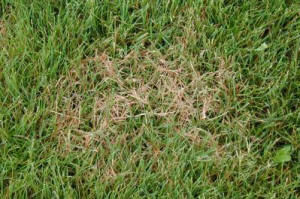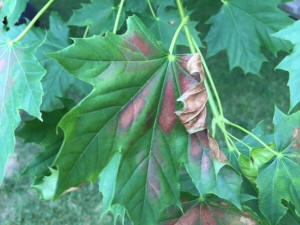|
 The main things actively growing in many lawns at this time are
called weeds. One of the traditional weeds during dry periods is
plantain. There are two common types of plantain in our area.
Buckhorn plantain has narrow leaves and a spiked seed head
(hence my term of buckhorn days). Broadleaf plantain has the
same type of seed head, but as the name suggests, it has broad
leaves. As the only green areas in some lawns, control with
2,4-D may be beneficial. Thatís assuming you donít want the
weeds and the unsightly green spots. Of course, the shaded areas
tend to be greener, and the pasture type grasses are faring
better than the ones we planted for our lawns as well. The main things actively growing in many lawns at this time are
called weeds. One of the traditional weeds during dry periods is
plantain. There are two common types of plantain in our area.
Buckhorn plantain has narrow leaves and a spiked seed head
(hence my term of buckhorn days). Broadleaf plantain has the
same type of seed head, but as the name suggests, it has broad
leaves. As the only green areas in some lawns, control with
2,4-D may be beneficial. Thatís assuming you donít want the
weeds and the unsightly green spots. Of course, the shaded areas
tend to be greener, and the pasture type grasses are faring
better than the ones we planted for our lawns as well.

New grass put out this spring is probably suffering the most. We
can add moisture, but not take away the heat. The heat is one of
the major factors in recommending spring seedings be completed
around April 1 to allow for establishment of the root system.

We are probably poised for a bout of lawn rust as well. Stress
conditions, such as the weather just experienced, followed by
cooler weather with dew are ideal for rust. The use of
fungicides on lawns isnít generally recommended, and the rust
will disappear as growing conditions improve. Also, conditions
which allow the grass to dry quicker will help prevent it. These
would include trimming low-hanging tree and shrub branches, and
watering in the morning to allow for drying during the daytime.
If you're in an area that hasn't received moisture for about a
month or more, you might want to consider watering with a
quarter of an inch or so to keep existing grass roots and crowns
alive. This should be done on a weekly basis. This won't green
up the grass, but will allow it to green up when it does start
raining. Most areas have caught a bit of moisture, but it is
hard for any plants to take up enough moisture to supply the
above ground parts with the type of weather we just went
through.
[to top of second column] |


Perennials are also suffering during this extended dry period.
There is evidence of scorch on recently transplanted trees,
shrubs, and other perennials. This is the fancy name for the
condition I mentioned in lawn grasses where the plant just canít
take up enough water to supply the leaves. In trees and shrubs,
it causes them to suddenly have brown leaves. It is a good idea
to water perennials (flowers, shrubs, trees, etc.) with an inch
of water a week. You can use a sprinkler and catch water in a
can to tell how much an inch is. As for using the deep root
feeders/waterers, most roots that take up water and nutrients
are in the upper foot of soil, so broadcast applications with a
sprinkler or watering wand are probably most effective and
easier to apply.
[By JOHN FULTON, COUNTY EXTENSION
DIRECTOR SERVING LOGAN, MENARD, AND SANGAMON COUNTIES]

 |